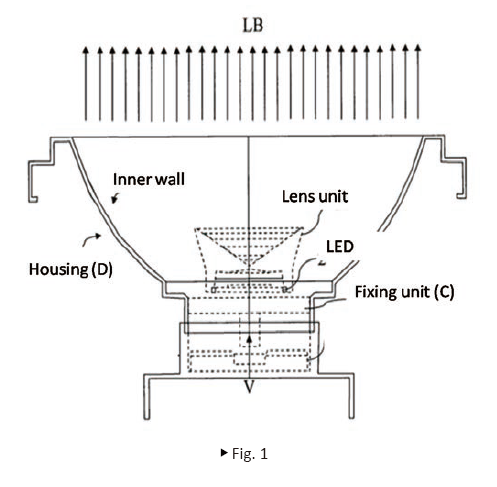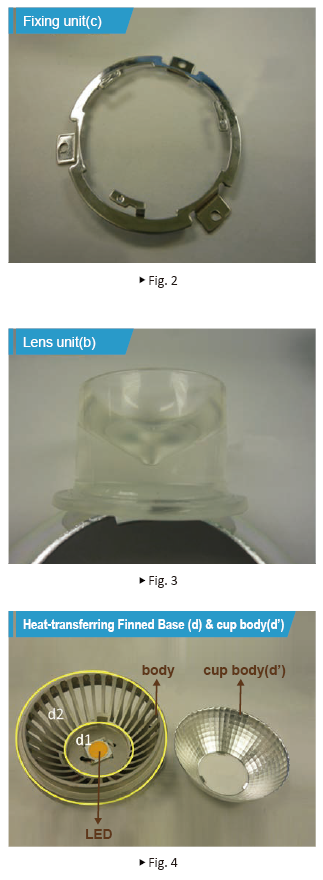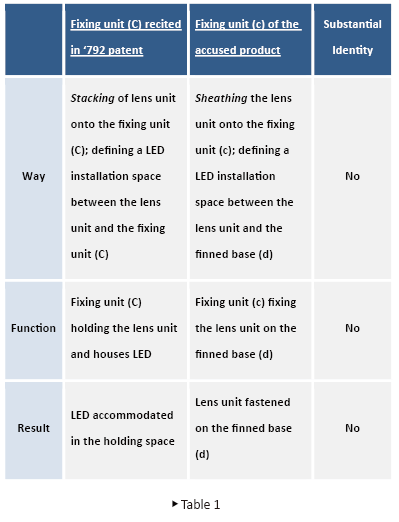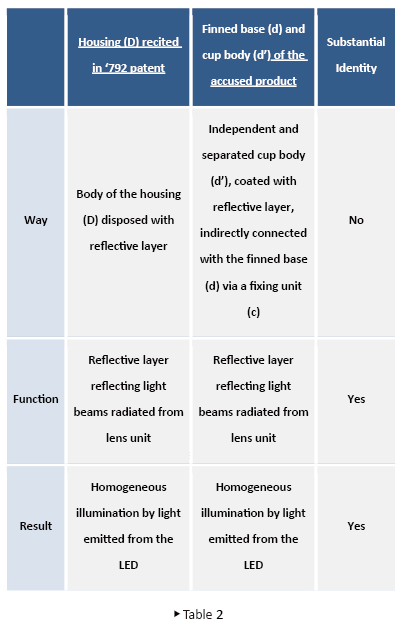Court Posed Limitation on Resolving an Integrally Formed Element during Infringement Analysis
Zhou (“Appellant”) as a patentee sued Ledionopto Lighting (“Respondent”) for infringing his utility model patent No. M472792 (‘792 patent), which relates to a reflective lamp cup for optical instruments. More particularly the ‘792 patent relates to a LED reflector, as shown in Fig, 1. In October of 2015, the IP Court (“Court”) denied all of Zhou’s claims in the first instance. Zhou appealed the case.

The case presented a key inquiry: how an element of the accused product can be resolved during the comparison for infringement analysis.
The Appellant asserted that the accused product was read on by his ‘792 patent literally, if not, or infringed under the doctrine of equivalents. The ‘792 patent’s Claim 1 recites that: a reflective cup-shaped lamp (A) to connect a light-emitting diode and a driving circuit, comprising:
(among others)
A fixing unit (C), having a second holding part and a base, wherein the lens unit is stacked on the fixing unit, wherein the first holding part and the second holding part form a holding space to hold the light-emitting diode;
A housing (D), having a body, a third holding part, an emitting part and a bottom, wherein the emitting part is at one end of the body, and the bottom is at the other end of the body, wherein the third holding part is configured in the housing, wherein a reflective layer is coated on the interior surface of the body, wherein the third holding part accommodates the fixing unit and holds the fixing unit on the housing; and
To the contrary, the Respondent contested that its product comprised a different fixing unit (c), a heat-transferring finned base (d), and a cup body (d’). As shown in Fig.2-4, the fixing unit (c) is a ring body able to sheath a lens unit (b). And then the cup body (d’) is coated with a reflective layer on the interior surface being engaged onto the fixing unit (c). Altogether the fixing unit (c) can be lockedly fastened at the bottom end of the heat-transferring finned base (d). A holding space for LED installation is thus defined as between the lens unit and the bottom end of the heat-transferring finned base (d).

In the absence of literal read-on, the Court investigated if the fixing unit (c), finned base (d), and cup body (d’) infringed on the equivalent scope of the ‘792 patent, meaning that the three elements perform substantially the same function by substantially the same way to yield substantially the same result. The Court’s analysis is illustrated as below tables.


Based on the all-element rule, the Court found that the accused product does not infringe the ‘792 patent under the doctrine of equivalents.
However, the Appellant continued to further argue that, in reference to TIPO’s Directions for Patent Infringement Assessment (TIPO’s Directions), multiple elements (z1+z2) in the accused products can be combined to compare with one technical feature (Z) of the claim, or vice versa. Following the rationale, the Appellant sought to propose two models where:
fixing unit (C) <-> fixing unit (c) + lower part of finned base (d1); and
housing (D) <-> cup body (d’) + upper part of finned base (d2);
or
fixing unit (C) <-> fixing unit (c); and
housing (D) <-> cup body (d’) + lower part of finned base (d1).
The Court rejected both proposed models partially because the Appellant wrongfully construed TIPO’s Directions. The Court emphasized that, by resolving a single element (d) and then combining the resulting sub-elements (d1 and d2) with other elements respectively (c and d’), the constitutional relationship and structural connectivity of said single element was destroyed. The Appellant seemingly re-arranged the accused product’s elements in a rather arbitrary and purpose-oriented approach. For an integrally formed element of an accused product, an intended resolution which undermines said element’s inherent and structural relation will not be permissible.
As the advocate for Respondent, Tsai, Lee & Chen challenged Appellant’s models whether, during infringement analysis, an element of the accused product can be further combined with different other elements in order to compare with different technical features of a claim. That is, it is doubtful if an element can be combined and then compared to more than one claim feature repetitively. To which however the Court did not opine expressively with a definite answer but rather put stress on the permissiveness of such resolution approach for the accused product, and eventually denied. In fact, neither TIPO’s Directions provides a satisfactory and comprehensive explanation on how an accused product should be resolved or how comparison should be exactly performed.
The Court in the second instance again ruled in favor of the Respondent mainly based on the afore-said reason. We expect that relevant controversies regarding resolution of a claim or an accused product may likely repeat.
for any questions relating to this topic, please contact us at cjchen@tsailee.com.tw
|